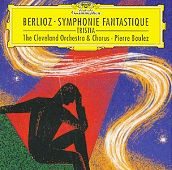Orquesta y Coro de Cleveland; Pierre Boulez.
Deutsche Grammophon 453416-2
[72'17"]

|
Hector BERLIOZ: Sinfonía Fantástica; Tristia. Orquesta y Coro de Cleveland; Pierre Boulez. Deutsche Grammophon 453416-2 [72'17"] |
 |
| Classical Insites |
Rating: 10
Pierre Boulez and the Cleveland Orchestra give us an exceptionally vivid performance of Berlioz' Symphonie Fantastique. In fact, what's so satisfying about this recording is that it gives equal measure to both the symphonic and the fantastic aspects of the music.
In an interview printed in the CD booklet, Boulez says that what attracts him most to this music is orchestral color (noting that Berlioz' work was composed only a few years following Beethoven's Ninth!). And, indeed, this is the most beautifully detailed realization of Berlioz' score that I gave ever encountered. Conductor and orchestra revel in every fleck of color, creating a transparent, shimmering canvas that is absolutely compelling from the first notes of the dreamy, druggy introduction to the blazing last chord of the demonic finale.
Every moment is perfectly judged and brilliantly executed: the schizoid mood swings of the opening movement, the graceful glamour of the «Ball» scene, the pastoral hush of the «Scene in the Country» and the overbearing bombast of the «March to the Scaffold». The «Dream of the Witches' Sabbath» is unusually weighty and serious here, making it less cartoonish than some wilder versions, but the effect is actually more fiendish.
The disc is filled-out with Tristia, a twenty-minute choral-orchestral triptych contemplating the subject of death. The first movement is a «Religious Reflection», based on a text by Thomas Moore; the remaining movements take inspiration from Shakespeare's Hamlet. While certainly performance makes the most of the work.
DG's recording is spectacularly clear and sweet. Highest possible recommendation.
| Gramophone |
There is something to be said for a sharply analytical version of the Symphonie fantastique, when this is not just a colourful and evocative example of programme music, but an extraordinarily original symphonic structure. Conductors as different as Klemperer and Previn have in contrasting ways concentrated on structure rather than atmosphere in their readings, and Pierre Boulez, too, might seem the ideal exponent of such an approach.
I wish that Boulez had chosen a French orchestra for this recording rather than the Cleveland. As it is, this is a powerful, sure-footed and beautifully played reading which is not only lacking in atmosphere, but also in poetry and emotional thrust. With rhythms crisp but lacking in spring, the result is unpersuasive, in part through its very certainty, out of tune with the inspiration of an arch-romantic in a way that neither Klemperer nor Previn is.
What is lacking in the performance of the symphony is highlighted by setting it against the fine, sympathetic performances of the first two of the three pieces making up Tristia, offered as a generous fill-up. There Boulez and his performers �including chorus, distantly balanced� are altogether warmer, with dynamics and textures still sharply terraced, but with an element of mystery totally missing in the symphony. In the third of the Tristia pieces, the «Funeral March» for the last scene of Hamlet, Boulez's reading tends to revert to the style of the symphony, for this is a plain, detached account of a piece which in its weird Berliozian eccentricity can yield far more than it does here.
The super-bargain issue from Arte Nova of the Symphonie fantastique offers a performance from the Gran Canaria Philharmonic under Leaper that may not be so high-powered as Boulez's, but which is subtler and more refined in its expressiveness, and consistently well paced. Its impact is enhanced by a recording which is both atmospheric and commendably transparent. A good bargain choice.
|
|